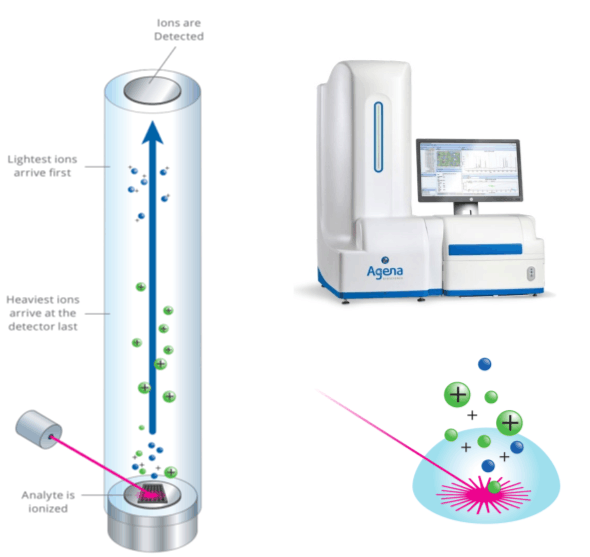Current location: Home > NEWS > Industry news
NEWS
PRODUCTS
Prevent Tuberculosis: Quick and Accurate Diagnosis and Treatment.
News source: Release time:[2024-03-25]
World Tuberculosis Day, observed on March 24th each year, commemorates the discovery of the tuberculosis bacterium by German microbiologist Robert Koch in 1882. The World Health Organization declared a global tuberculosis emergency in 1993 during the 46th World Health Assembly held in London and actively promotes the importance of prevention and treatment of this disease.
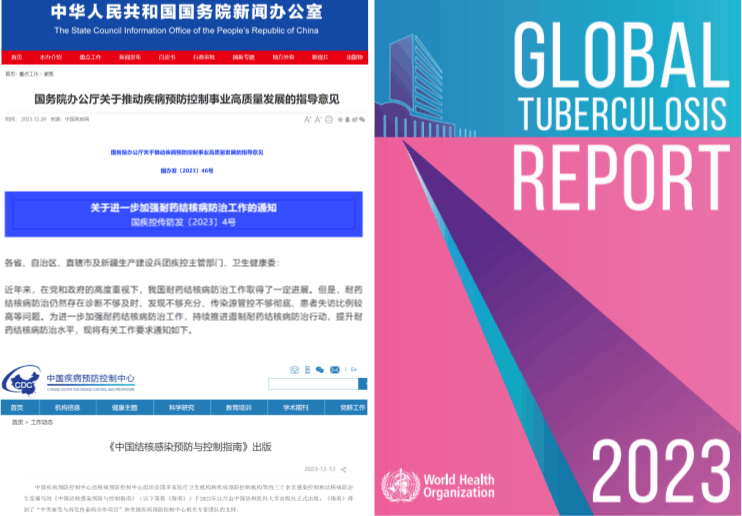
Global Tuberculosis Report 2023
On November 7, 2023, the World Health Organization (WHO) released the "Global Tuberculosis Report 2023". By 2022, after two years of the COVID-19 pandemic, the number of people diagnosed with and receiving treatment for tuberculosis had significantly recovered globally. However, tuberculosis remains the world's second-largest single infectious disease cause of death, second only to infection with the novel coronavirus.

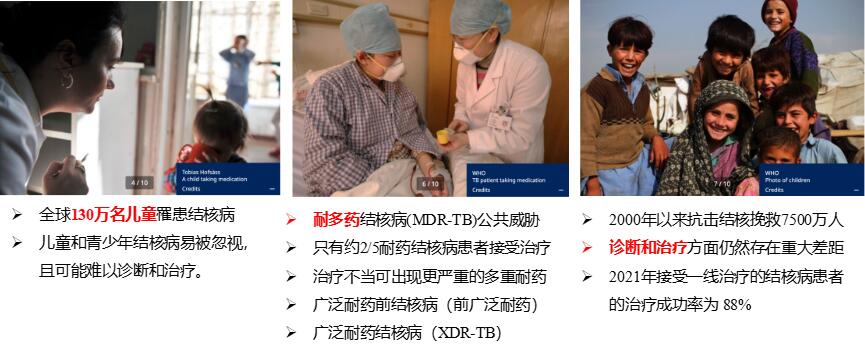
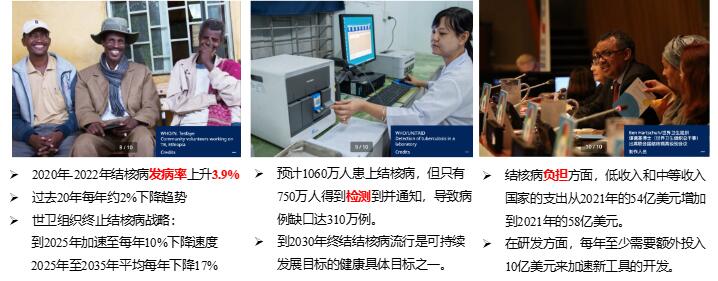
Tuberculosis burden and national conditions
Thirty high burden countries for tuberculosis account for 87% of the total global incidence, mainly concentrated in the regions of Southeast Asia, Africa, and the Western Pacific, with eight countries contributing to over two-thirds of the global incidence.
Tuberculosis is not hereditary but can be transmitted. Early diagnosis and treatment benefit oneself and others.
01
In fact, not all types of tuberculosis are contagious, nor is every tuberculosis patient infectious at all times during the course of the disease. Some individuals can clear the tuberculosis bacteria through their own immune response, or temporarily coexist with the bacteria (approximately 5%-10% of latent infections may progress to active tuberculosis). Overall, if diagnosed with tuberculosis, there's no need to panic, but it's important not to seek medical attention blindly or conceal the condition, to avoid treatment delays and the transmission to others.
02
The treatment principles for tuberculosis include early, combined, adequate, regular, and full-course therapy. If medications are not taken on time or if treatment is discontinued prematurely when symptoms improve, it can easily lead to drug-resistant tuberculosis or relapse. Once drug resistance occurs, treatment duration increases, treatment becomes more challenging, treatment costs rise, and the mortality rate increases.
03
Tuberculosis is not hereditary. If pregnant women have tuberculosis, contraceptive measures should be taken. If already pregnant, it's best to terminate the pregnancy. Generally, normal pregnancy can resume six months after being cured, and any doubts should be discussed with a specialist.
Spacegen solutions
| Product | Detection | Specification | Sample type | Method | Applicable instrument | Significance |
Human Lung Tissue Mycobacteria Identification Detection Kit | Mycobacterium tuberculosis complex and 26 pathogenic mycobacteria | 40 Tests/Kit | paraffin embedded tissue | nucleic acid mass spectrometry | MassArray® DNA mass spectrometry Gene analysis system | Rapidly identify 26 species of mycobacteria and the Mycobacterium tuberculosis complex |
Mycobacterium Tuberculosis Drug-resistant Mutation Detection Kit | Common resistance mutation sites of 6 anti-tuberculosis drugs (rifampicin, ethambutol, fluoroquinolone, isoniazid, streptomycin and pyrazinamide) | 40 Tests/Kit | Identification of pathogenic bacteria (invasive fungi) in lung infections | |||
Human Lung Tissue Infection Multi-Test Kit | Mycobacterium tuberculosis complex and common resistance mutation sites of 26 pathogenic mycobacteria, 30 invasive fungi, and 6 anti-tuberculosis drugs | 20 Tests/Kit | Rapidly identify 26 species of mycobacteria, Mycobacterium tuberculosis complex, and 30 species of invasive fungi; assess the sensitivity of tuberculosis patients to anti-tuberculosis drugs and assist in the customization of anti-tuberculosis treatment plans. |
Human Lung Tissue Mycobacteria Identification Detection Kit (nucleic acid mass spectrometry method)
The proportion of diseases caused by non-tuberculous mycobacteria (NTM) globally is on the rise. In many developed countries, NTM diseases have even surpassed tuberculosis, accounting for as much as 70%-80%. The isolation rate of NTM in China is also increasing year by year, with higher rates in the southern and coastal regions compared to the northern and inland regions. Clinical manifestations, chest imaging, and lung diseases caused by NTM are very similar to tuberculosis, yet distinct from it. In conditions where diagnostic resources are limited, misdiagnosis or missed diagnosis is highly probable. Furthermore, due to the diversity of NTM species (over 200 species identified so far), different NTM strains exhibit varying antibiotic resistance profiles, requiring distinct treatment approaches. Failure to accurately identify the species of pathogenic NTM during testing and administer targeted medication may lead to misdiagnosis as drug-resistant tuberculosis or ineffective treatment resulting in repeated therapy. Therefore, accurate identification of Mycobacterium species in lung tissue is crucial for the diagnosis and treatment of the disease.
| Mycobacterium tuberculosis complex and 25 pathogenic mycobacteria | |||||
Mycobacterium tuberculosis | Mycobacterium flavus | Mycobacterium phlei | Mycobacterium intracellulare | Mycobacterium suis | new mycobacterium aureus |
Mycobacterium kansasii | Mycobacterium scrofula | Mycobacterium gastric | Mycobacterium chelonae | Mycobacterium aureus | chromogeneless mycobacteria |
Mycobacterium fortuitum | Mycobacterium smegmatis | Mycobacterium sulgaris | Mycobacterium avium | Mycobacterium minora | Mycobacterium terreus |
Mycobacterium abscessus | Mycobacterium ulcerans | Mycobacterium dieli | Mycobacterium gordonii | Mycobacterium marinum | Mycobacterium vaccae |
Mycobacterium xenopus | Mycobacterium simiae | Mycobacterium tuberculosis complex | |||
| 6 types of tuberculosis drug resistance | |||||
| Rifampicin | Ethambutol | Fluoroquinolone | Isoniazid | Streptomycin | pyrazinamide |
Mycobacterium Tuberculosis Drug-resistant Mutation Detection Kit (Nucleic Acid Mass Spectrometry Method)
Tuberculosis caused by Mycobacterium tuberculosis infection is one of the most serious infectious diseases that seriously endanger human health. Mycobacterium tuberculosis with drug-resistant mutations can develop resistance to anti-tuberculosis drugs, and drug-resistant tuberculosis has always been a key and difficult point in tuberculosis prevention and control work. Its lengthy treatment course and high cost pose a serious threat to the health of society and the people. Therefore, accurate detection of drug-resistant mutations against anti-tuberculosis drugs is crucial for the diagnosis and treatment of tuberculosis. Although there are various methods available for detecting drug resistance, each has its limitations. Currently, rapid drug resistance testing mainly adopts molecular biology methods. At present, our company provides test kits that can detect the following target gene mutations in clinical settings: rifampicin (RFP) resistance-related gene rpoB, isoniazid (INH) resistance-related genes katG and inhA, streptomycin (Sm) resistance-related gene rpsl, ethambutol (EMB) resistance-related gene embB, fluoroquinolone (FQ) drug resistance-related genes gyrA and gyrB, and pyrazinamide (PZA) resistance-related gene pncA.
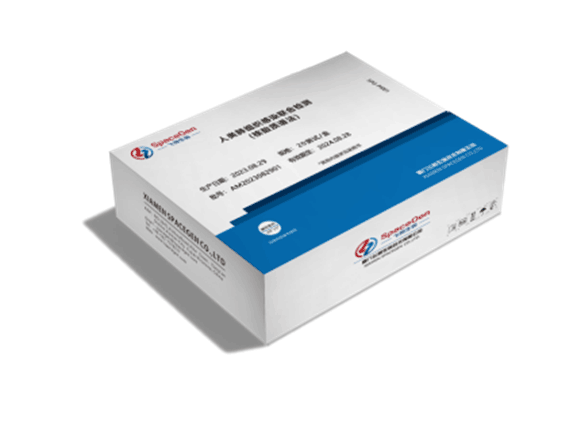
In summary, the identification of Mycobacterium tuberculosis and non-tuberculous mycobacteria pairs, as well as guidance on drug resistance, is crucial. Through precise diagnosis and personalized treatment of patients, we will continually improve the cure rate of tuberculosis, providing better quality of life and prognosis for patients. In future research, we will continue to explore more effective diagnostic and treatment methods, providing strong support for tuberculosis prevention and control efforts.
Appendix of Knowledge Points:
01.
Appendix A: Classification of Drug-Resistant Tuberculosis
Single-Drug Resistant Tuberculosis (SDR-TB): Tuberculosis patients infected with Mycobacterium tuberculosis confirmed to be resistant to one first-line anti-tuberculosis drug in vitro.
Poly-Drug Resistant Tuberculosis (PDR-TB): Tuberculosis patients infected with Mycobacterium tuberculosis confirmed to be resistant to more than one first-line anti-tuberculosis drug (including isoniazid and rifampicin) in vitro.
Multi-Drug Resistant Tuberculosis (MDR-TB): Tuberculosis patients infected with Mycobacterium tuberculosis confirmed to be resistant to at least isoniazid and rifampicin in vitro.
Rifampicin-Resistant Tuberculosis (RR-TB): Mycobacterium tuberculosis found to be resistant to rifampicin using phenotypic or genotypic methods, regardless of resistance to other anti-tuberculosis drugs.
Extensively Drug-Resistant Tuberculosis (XDR-TB): Mycobacterium tuberculosis infecting tuberculosis patients confirmed to be resistant not only to the two main first-line anti-tuberculosis drugs, isoniazid and rifampicin, but also to any fluoroquinolone antimicrobial drugs and at least one second-line injectable anti-tuberculosis drug (such as capreomycin, kanamycin, and amikacin).
Pre-Extensively Drug-Resistant Tuberculosis (pre-XDR-TB): Meeting the definition of MDR-TB while also being resistant to any fluoroquinolone drugs.
02.
Appendix B: Technological Platforms
The MassARRAY® system is a platform based on mass spectrometry analysis, highly sensitive and cost-effective, widely used in various fields worldwide, such as identification of bacteria/viruses/fungi, pharmacogenetics, cancer analysis of solid tumors and liquid biopsy specimens, genetic disease testing, agricultural genomics, and clinical research.
